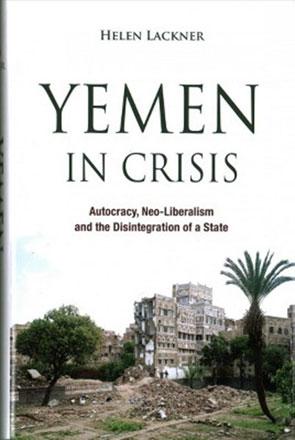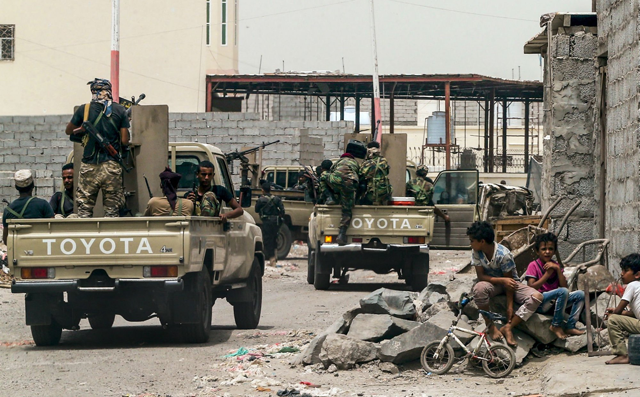You are here
Taking sides with Yemeni people
Apr 01,2018 - Last updated at Apr 01,2018

Yemen in Crisis: Autocracy, Neo-Liberalism and the Disintegration of a State
Helen Lackner
London: Saqi Books, 2017
Pp. 330
The title of this book might seem to indicate that it covers only the current situation, but it is much more. In explaining today’s crisis, Helen Lackner has written what amounts to a post-colonial history of Yemen. A social anthropologist, researcher at SOAS and leading authority on Yemen, Lackner’s involvement with the country is not solely academic. For fifteen years, she lived in different parts of Yemen, working on rural development projects. This might explain her admiration for Yemen’s natural beauty, as well as her committed, pro-people approach to its multifaceted crisis and how it could be solved once the war ends. For each of the socioeconomic facts and figures cited, she gives concrete examples of exactly what they mean for people’s lives.
Tracing Yemen’s downward spiral from the 2011 popular uprising to the failed democratic transition and finally civil war and humanitarian disaster, Lackner is stringently objective and does not take sides among the competing, local, political and military forces and their shifting alliances. Instead, she adamantly sides with the Yemeni people: “None of the players involved demonstrated the slightest concern for the welfare of the 27 million Yemenis, most of whom suffered worsening conditions on a daily basis.” (p. 53)
Her critique extends far beyond the Yemeni elite and political/military factions to encompass the Gulf Cooperation Council countries and international powers. “Throughout, the US administration has shown that support for the Saudi regime and arms sales, which spell cash for their companies, took priority over human rights and human life in Yemen.” (p. 88) The other US priority in Yemen is counter terrorism (drone warfare), whereas “for most Yemenis, jihadism is an insignificant threat in comparison with hunger, disease and other survival-related issues they face on a daily basis”. (p. 26) Also, the UK is singled out as being unwilling to alienate the Gulf states which it hopes will invest in its post-Brexit economy. All in all, “US military strikes and the intervention of the Saudi-led coalition since March 2015 have transformed Yemen into a country where external forces are pursuing their own geopolitical struggles, which have little or nothing to do with Yemenis.” (pp. 94-5)
Lackner’s coverage of Yemen’s history is both comprehensive and in-depth, backed up by statistics and enriched with her own insights into the major political, social and economic transformations of half a century. After covering Yemen’s relations with the rest of the world, from its high rate of labour emigration to foreign interference, she analyses the period when there were two Yemeni republics and what factors led to reunification—developments which have seldom been analysed so clearly.
The only potentially game-changing event to occur since “Yemen in Crisis” went to press is the assassination of former president Ali Abdullah Saleh, but this does not change any of the book’s contentions. Dead or alive, his shadow looms large in the country’s fragmentation and increasing poverty due to his strategy of playing different parties off against each other, his corruption-riddled patronage system, mismanagement of the oil industry and embrace of the neoliberal model. All of this is analysed in detail in the book, and especially how it dramatically increased inequality, dividing Yemenis into a small elite dependent on connections to Saleh, and the vast, poor majority.
Lackner identifies water scarcity on a par with war in terms of threatening Yemen’s very existence. A big part of the problem is big landowners’ over-exploitation of water for irrigation of high value crops — a problem ignored by the former government as Saleh relied on the support of these powerful individuals. Equally to blame is the fact that “external financiers prioritised their international neo-liberal agenda which emphasised the development of high-value export crops at the expense of local food security and the living conditions of the majority”. (p. 225) This was compounded by the fact that many international donors have consistently failed to honour their pledges, and often funded counterproductive projects.
Yemeni society and the political movements it has spawned are highly complex. Yet, Lackner does an admirable job of tracing the rise and growth of influential movements from the Islamists to the Houthis and the southern separatists, and the relations among them, in terms of class, regional and tribal affiliations, as well as historical factors. Particularly interesting is her treatment of tribes whose role has often been misinterpreted. “It is often claimed that jihadis operate in alliance with tribes, something which largely derives from the complete [and often deliberate, some might say racist] misunderstanding of the nature and dynamics of Yemeni tribes.” (p. 141)Her analysis of tribes and their relations to the state and various political/military forces contains insights which could be applied to tribes in other countries and contexts.
Lackner’s arguments are impeccably logical, her writing is lucid and bold. The preface begins with the one-word sentence: Hope — hope for the war to end and for Yemenis to be enabled to embark on more equitable development. “Yemen in Crisis” will be useful to experts and to those seeking new understanding of the subject. Enhancing its clarity and usefulness, the text is prefaced by three excellent maps, a glossary, note on transliteration and abbreviations and a timeline from 1839 (the British occupation of Aden) to July 2017.
Sally Bland
Related Articles
“Why Yemen Matters” is a remarkable book in terms of its comprehensiveness, accessibility and ethical approach. Comprising articles by 18 scholars, many of whom have spent extensive time in the country, it covers Yemen’s politics and economy from the early 20th century to the 2011 uprising and its aftermath, with social issues woven into the overall analysis.
ADEN — Yemen’s Huthi rebels have been disrupting internet access nationwide as they consolidate their grip of the capital, residents and an
DUBAI — Saad Al Awlaki has taken the helm of Al Qaeda in the Arabian Peninsula (aqap) after the death its former leader, looking to unite th



















